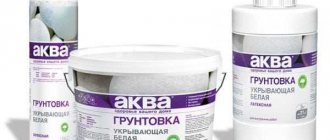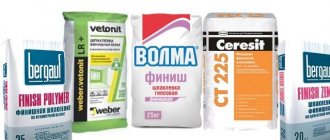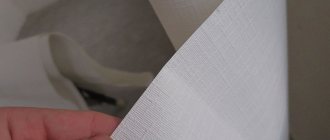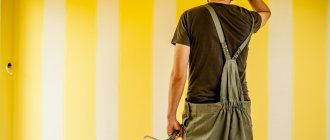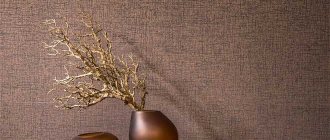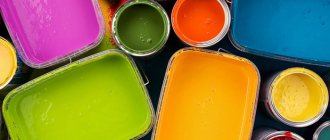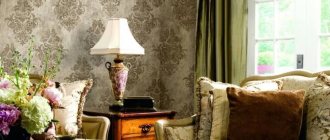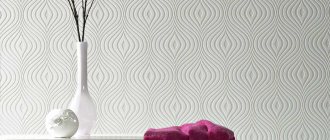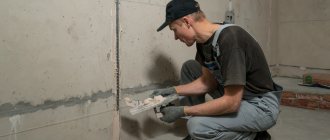How to determine that wallpaper is intended for painting
Contrary to popular belief, wallpaper intended for repainting is not always embossed; many have a smooth surface. And not all wallpaper with embossing and relief will withstand the experiment of repainting.
Qualified help can be obtained from a consultant, but he is not always available nearby. The easiest way is to study the markings. Regardless of the material of manufacture, the possibility of repainting is indicated on the packaging or in the instructions. For example, the abbreviation CTP indicates that this is a structural coating, in most cases intended for painting.
Tapestries for painting are manufactured in many countries, but Germany remains the leader. Products from German manufacturers (Erfurt, Marburg, Vitrulan, Rasch) are distinguished by their design diversity and high quality. For example, the density of non-woven trellises is 1.5 times higher than that of domestic analogues. And some types of canvases are called the German term raufazer. English companies Lincrusta and Anaglypta also produce high-quality wallpaper for painting.
Two-color wall design Source pinimg.com
Canvases intended for repainting are externally indistinguishable from ordinary rolls, but are kept separately on the sales floor. They can be recognized by the following characteristics:
- In most cases, the width of the roll is increased to 1-1.2 cm. A wide canvas is convenient for large rooms - there are fewer scraps.
- The fabric is more dense in structure. Some types of material are much thicker, which is why the roll looks bulky. Such characteristics help to withstand several layers of paint and maintain the appearance unchanged.
- The base color of most collections is white, but there are options in beige, milky, or other pastel colors. In the latter case, the applied paint acquires a more saturated and original shade.
A variety of textures to suit every taste Source abstinencedu.com
How to glue wallpaper and apply paint to it?
No special leveling of walls is required for such wallpaper. Only when there are large irregularities do they need to be corrected.
The step-by-step pasting process consists of the following points:
- You should start with a good primer, we recommend Ceresit ST 17. High-quality, applied in 1-2 layers.
- Choose glue depending on the type of wallpaper, pay attention to the markings on the packaging. When preparing, follow the instructions. Wallpapers with a non-woven backing are often purchased; the adhesive that works well with them is KLEO Extra.
Trick ! If you mix wallpaper glue with PVA in a ratio of 1:0.5, then this mixture will save you from having to glue the wallpaper every year.
- Measure the height of the walls with a tape measure and cut the roll into strips of the required length. If the wallpaper contains a specific pattern, you will have to match it to each strip and lay it out so that it is not mixed up when sticking.
- They begin pasting the walls from the windows. Mark the width of the sheet on the wall. This is necessary to apply glue for each of the strips.
- Carefully treat the wall with glue. Do not apply glue to the wallpaper.
- Take a sheet, apply it to the wall and smooth it out thoroughly.
- Don't overlap. Wallpaper to be painted should be glued end to end.
Avoid drafts during the entire working and drying period. Close the windows.
After completely covering the room, the wallpaper should be allowed to dry completely. This process takes on average 12-48 hours and depends on several factors: the base and thickness of the wallpaper, the adhesive used, and the level of humidity in the room. Then all that remains is to choose paint and transform the interior.
Each type of wallpaper requires a certain paint:
- on a non-woven base should be painted with water-based or acrylic paint;
- paper-based - water-based;
- glass wallpaper - latex or acrylic.
Acrylic paint is distinguished by its moisture-resistant properties, but is limited to matte shades only. But it is the matte options that are most popular for interior decoration. Additionally, in living rooms, attention should be paid to the environmental friendliness of the coating, absence of odors and quick drying.
Read about which paint is best for painting wallpaper.
The painting process consists of the following steps:
- Preparing paint for work, mixing it thoroughly to ensure uniform color;
- First, corners and slopes are painted with a brush;
- Before painting the slopes, cover them with masking tape.
- The rest of the surface is painted over with a roller, leaving no empty spaces;
- After the first layer has dried, repeat the procedure in the same order.
Advantages and disadvantages
The main advantage of the material is obvious: it provides the opportunity to repeatedly update the interior. Additionally, you receive the following benefits:
- Finding a suitable finishing material is not difficult. There is a large selection of manufacturers, prices, materials, textures and patterns on the market.
- The update will be quick and inexpensive: wallpaper is only applied the first time. Next, you will only invest in paint; the walls will not require any preparation. There are no restrictions on color choice.
- Dense and thick material can serve not only as decoration, but also as a camouflage, hiding an uneven wall surface with defects.
- When choosing trellises, you must take into account the following disadvantages:
- Some collections can hardly be called budget.
- Paint can hide a pattern on inexpensive material with poorly defined relief. It is especially unpleasant if this happens unevenly over the surface.
- The number of colors is limited. Different types of wallpaper are designed for 4-5, 6-10 or 10-15 layers of paint, which is reflected in the cost of the rolls and is indirectly visible in the depth of the relief.
Imitation of natural texture
See also: Catalog of companies that specialize in finishing materials and related work
Sizes of paintable wallpaper
The sizes of paintable wallpaper rolls differ from standard ones. There are wallpapers with dimensions: 17 x 0.53; 33.5 x 0.53;
25 x 1.06, and sometimes even 125 x 0.75 m. Such a significant length and width makes it possible to cut the material more economically and reduce the number of joints between strips. Therefore, when choosing wallpaper for painting, you need to take this into account and correctly calculate the total number of rolls.
Paintable wallpaper is produced by the following manufacturers: • AS CREATION (Germany) • ASSATEX (Finland), • ERFURT • ERISMANN • MARBURG • MERMET (France) • TASSO GLASS (Sweden).
Types and characteristics
Technologically, paintable wallpaper differs in the manufacturing method, the number of layers and the materials used. This affects the way the material is glued to the walls. Based on the type of base, there are three types: paper, non-woven and fiberglass, each with its own set of qualities.
Paper
The use of paper makes them the most environmentally friendly material, but completely paper trellises are rare. More often you can find paper-based vinyl rolls on sale, which makes environmental friendliness questionable. Paper trellises for painting have a different number of layers and also differ in texture; they can be painted up to 5-7 times. You can choose between the following options:
- Raufazer. Dense three-layer material with a chaotic relief pattern, which is created by crushed sawdust placed between the layers. Raufazer is a low-cost way to level walls and disguise unevenness (scratches, sinkholes). The material shrinks when wet, so coat the canvas with glue and wait until it saturates the layered structure.
Wall decoration in a Scandinavian interior Source j.etagi.com
- Fleece Raufazer. The bottom layer of material is processed (additionally impregnated) during production, so when wet the canvas does not change proportions. The glue is applied to the wall, and the decor is glued dry, which is very convenient.
- Embossed. They are quite expensive to produce; Cellulose paper is used as the front surface. Thanks to this solution, the material absorbs less dye, which reduces its consumption. In the economy version, the top layer is made of vinyl; Such trellises shrink when wet, and it is difficult to call them environmentally friendly.
- Embossed. For expensive brands, the base is paper, and the textured surface is made from a mixture of wood flour, wax, chalk and other components. The front layer is fragile when rolled, but on the wall it hardens every year. More affordable brands have a base made of vinyl. Relief finishing is difficult to apply; it is strongly recommended to invite craftsmen with relevant experience.
Partial roller painting Source pinimg.com
Non-woven
The fabric is made from cellulose fibers treated with high temperature and pressure. Elastic and durable non-woven fabric has many advantages. This is an environmentally friendly material that does not cause allergies and is not afraid of changes in humidity and temperature. Wallpaper made from non-woven fabric is described by the following set of characteristics:
- Options are available with a smooth and textured front layer. The textured pattern is obtained by embossing.
- Two-layer non-woven wallpaper is designed for 10 years of operation and 12-15 repaintings. They are quite expensive and therefore less common than their cheaper non-woven vinyl counterparts.
Non-woven paper-based wallpaper Source aviarydecor.com
- An important quality of non-woven fabric is the absence of shrinkage. The gluing process is quick, since the glue is applied immediately to the wall and there is no need to wait until the material is saturated.
- Most European rolls have a width of 1 m and a length of up to 25 m. Therefore, despite the rather high cost (when compared with paper), they are considered economical.
- You should avoid obviously cheap non-woven wallpaper that can be painted. Low cost is achieved by reducing the number of non-woven fibers. The difference in quality becomes evident during pasting. Mostly paper material behaves like ordinary paper: it shrinks when impregnated with glue. When drying, the seams begin to separate, which non-woven fabric never allows itself to do.
Textured finishing in a classic interior Source pinimg.com
Advantages of wallpaper for painting
Until quite recently, as a finishing material, many people preferred ordinary wallpaper with a ready-made pattern, design and color, but in recent years many other options have appeared on the market, with the help of which they can give rooms an original appearance. For this reason, other suitable solutions should be considered in more detail before making a final choice.
One such option is special wallpaper that can be painted with any paint. Paintable wallpaper, after opening with the mixture, gives all rooms an originality, and thanks to a number of their positive indicators, even in a relatively short period of time they began to be in significant demand on the market. Their advantages include the following qualities:
- A huge variety of colors and shades to choose from. This feature is one of the main reasons why they are preferred. Ready-made wallpaper is available in a significantly smaller number of colors. Paintable wallpaper, in contrast, can be painted with paint of any desired color, and if you cannot find a suitable option on sale, then you can mix several compounds together to obtain the desired shade.
- Moisture resistance. Wallpaper fabrics of this variety tolerate moisture well.
- Possibility of re-painting at any time. One of the key features of wallpaper can be painted, which eliminates the obligatory need to rip off and cover surfaces with wallpaper if there is a need or desire to change the appearance of the walls. In this case, they should only be pre-bleached and then re-painted with paint of a suitable color. Re-painting of such wallpaper can be done a large number of times.
Note! Basically, wallpaper for painting is made in white color, thanks to which paints of all shades look as high quality as possible. Much less often they are performed in cream, beige, lemon, blue and pink tones.
- Environmentally friendly. During operation, such wallpaper fabrics do not emit fumes harmful to human health and the environment, and they do not cause allergies.
- A large number of textures. Paintable wallpaper is available not only in the form of a plain white canvas. Now on sale there are various solutions with oriental patterns, geometric shapes and much more.
In view of this, you can easily find a material not only in accordance with personal preferences, but also which will allow you to create an original interior that perfectly matches furniture and other items. - Some types of wallpaper for painting may be subject to special care, during which they can be washed and cleaned.
- High wear resistance and long service life. Wallpaper for painting is produced using modern technologies, due to which, in finished form, their service life is quite long and they do not lose their positive qualities for a long time, even with regular painting.
- Easy to stick. Before gluing, the surface of the walls does not need to be specially prepared for them. You can paste wallpaper for painting without the help of craftsmen, which is why you can save a lot of money when doing the work yourself.
- Hiding defects. Thanks to their increased level of density compared to conventional wallpaper, during pasting it is possible to hide small irregularities and other imperfections that are present on the surface. In addition, they eliminate the formation of small cracks and provide general strengthening of the walls.
- Paintable wallpaper has increased sound insulation and heat insulation properties.
- With their help, you can paste not only walls, but also ceilings.
In addition, the relief structure of these wallpapers ensures uniform inclusion of color pigment into the texture, which retains the rich color perfectly and over a long period of time, and they also comply with all fire safety standards.
What is the selection criterion?
To decorate rooms, wallpaper made from different materials is selected. To make your final choice, you should take into account the following factors:
- Dimensions of the room. They affect the size of the relief and the shade of the paint. For a small room, a harmonious choice would be a material with a fine textured pattern and paint in a light palette.
- Functionality of the room. Choose wall finishing from the point of view of reliability, abrasion resistance, resistance to stains, and environmental friendliness.
- Type of artificial lighting. It is taken into account if washable wallpaper is chosen as finishing: glossy surfaces are not appropriate in all interiors.
- Repair goals. If you rent an apartment or are not planning a full renovation soon, choose cheap paper finishing, which you can part with without regret in 3-5 years.
Large ornament for a large space Source ak1.ostkcdn.com
It is also worth considering the expected decorative effect. Choose rolls with a pattern that matches the style of the interior. If you want to purchase textured wallpaper for an accent wall, do not forget about the thickness. It should coincide with the thickness of the plain fabric so that there are no noticeable joints at their border.
Tapestries can be smooth, imitate brickwork, stucco patterns, plaster, or an aged surface. In spacious rooms, decor with a large textured pattern, including those with a volumetric effect, will have an acceptable look.
If your goal is not only to refresh the interior from year to year, but also to disguise wall defects, use the following tip:
- To disguise small irregularities, smooth trellises for painting will suffice; A thickness of 100 g/sq. is enough. m.
- Small irregularities will be invisible under a textured coating with a clear, medium-sized pattern. Use wallpaper of medium thickness (130-160 g/sq. m).
- Multiple defects can be hidden under textured material with a chaotic pattern with a thickness of 200 g/sq. m.
Wallpaper with a border effect Source kraski-net.ru
Decor for rooms with different functionality
Owners who have made a choice in favor of reusable wallpaper and are deciding how to paint wallpaper for painting understand that the design of the finish is far from the only criterion. It is important to understand that different types of material are preferred for different rooms; in most cases, the following choice is appropriate:
- To the living room. The main principle of choice is aesthetic, so you shouldn’t skimp on finishing. It can be anything, the main thing is that the interior is harmonious and stylish.
- To the bedroom. The best option would be paintable non-woven wallpaper with a relief that matches the style. A budget replacement for non-woven fabric will be a paper finish, which is just as safe, but less durable.
Trim with floral relief Source pinimg.com
- To the nursery. In addition to appearance, environmental friendliness and practicality are important. These qualities are best combined in glass wallpaper - they are easy to clean from paint, grease stains and plasticine. For older children, non-woven trellises are suitable. Juniors can choose paper; when the child grows up, it can be easily replaced with better quality material.
- To the kitchen. The strength and wear resistance of wall decor is important here. The optimal choice is glass wallpaper, followed by non-woven fabric. Paper may be a temporary solution.
- In the bathroom. If you decide to decorate your bathroom with wallpaper, choose glass wallpaper that is not afraid of water. We must not forget that the paint also needs to be moisture resistant.
Glass wallpaper on the bathroom wall Source ohmeohmyblog.com
- In the hallway. The room has its own specifics, so any trellis that can be washed and often repainted is suitable for decoration. Fiberglass best meets these requirements, but if you need to save money, non-woven fabric will do. It is better not to look at the paper - it will quickly become unusable.
What about vinyl and non-woven?
Vinyl wallpaper, although it mostly has a paper base, is more durable and moisture-resistant than paper. There are three types of such materials: foamed vinyl, kitchen vinyl (the name speaks for itself, they can also be used for finishing bathrooms) and flat vinyl, which is also called silk-screen printing, or satin.
Non-woven options come in two types: non-woven based with a top layer of foamed vinyl, and completely made of non-woven. Rolls of this material are very durable and resistant to mechanical stress.
So, is it possible to paint vinyl and non-woven wallpaper? Of course you can!
- As for vinyl wallpaper, it is advisable to paint foamed vinyl first. This means that the strength of the material will, in any case, allow you to apply paint to them. But will silk-screen printing become more beautiful after this?
- Non-woven fabric, due to its strength, can be repainted in different colors from five to ten times.
How to choose the right paint
When choosing a dye, I pay attention not only to the shade, but also to the texture. Matte, semi-matte (velvet) compositions smooth out the unevenness of the walls, but at the same time make the room visually smaller. Glossy texture (or paint with mother-of-pearl, shiny particles) has the opposite effect: it expands the space and emphasizes unevenness.
The following compositions are used for painting trellises:
- Water-based paint. Budget ink with appropriate quality, suitable for paper. Plus - environmental friendliness. There are more disadvantages: it takes a long time to dry, has poor coverage, and is destroyed by ultraviolet radiation. Wet cleaning is contraindicated.
Hiding power is important for paint Source pinimg.com
- Acrylic. Dries quickly, forms a wear-resistant layer on the surface that is not afraid of water. It has good hiding power and is suitable for glass wallpaper, non-woven fabric, vinyl, but the paper may not withstand even the first layer.
- Silicone based paints. Universal compositions suitable for painting trellises of any type and density. The composition is easy to apply, dries quickly, and is easy to clean; the color is uniform. There is only one drawback - the high price.
Accent wall in the living room Source pinimg.com
Briefly about the main thing
Paintable wallpaper is a non-standard, but for many reasons, profitable way to decorate walls in any room. They make it possible to quickly and inexpensively update the interior, but for different types of trellises the number of colors varies quite a lot.
Reusable decor is made using different technologies, which determines the difference in the properties of paper, non-woven, vinyl and glass wallpaper. Wallpaper for painting is chosen based on the functionality of the room, its size and budget. When choosing, take into account the decorative qualities and size of the pattern. A dye with a good level of environmental friendliness and hiding power is suitable for coloring; in many cases its moisture resistance is important.
Ratings 0
If renovations are just planned...
If you are just planning a renovation, then you don’t need to think about which wallpapers you can and cannot paint, and whether your already covered walls are suitable for painting. The consultant in the store will tell you which wallpaper and which paint is best to paint in order to do everything correctly and get a good result.
As a rule, specialized stores have a large selection of special finishing materials for painting. They can be either paper (only much denser than duplex), or vinyl, or non-woven. The main difference between such wallpapers and decorative ones is their high density and the use of special technologies for their production.
